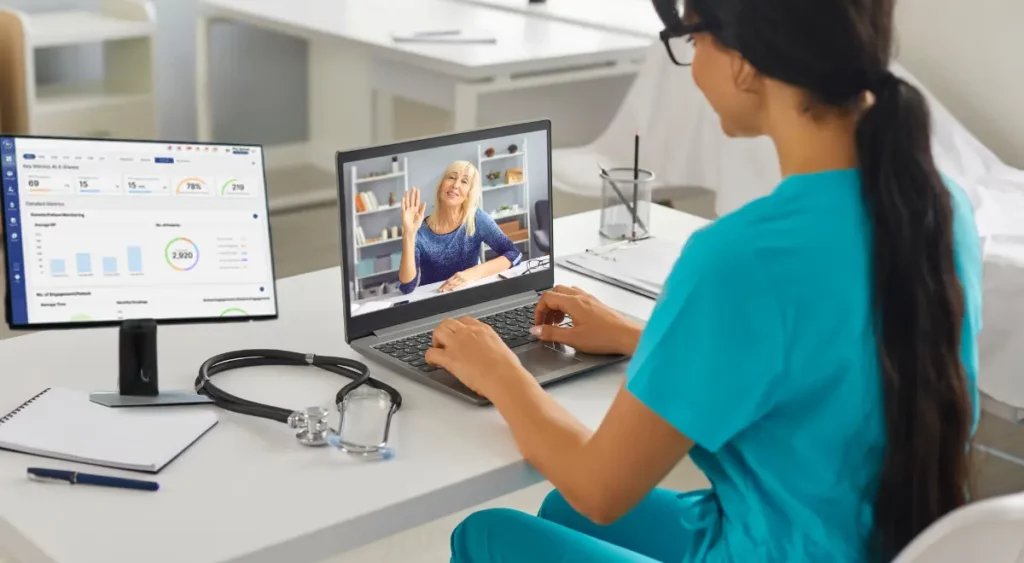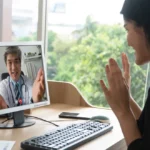How Remote Patient Monitoring Software Improves Patient Care Delivery

Remote Patient Monitoring (RPM) is a core digital health technology that goes beyond virtual consultations by providing real-time patient data between visits. As per a 2024 report, the RPM services market was valued globally at approximately USD 11.48 billion and is expected to grow at a Compound Annual Growth Rate (CAGR) of 34.94% from 2025-2034 to around USD 229.87 billion by 2034.
This rapid growth can be attributed to many factors, including the rising burden of managing chronic conditions, especially among the elderly population and meeting the increased demand for personalized healthcare at an affordable price. RPM technology has transformed care coordination by enabling healthcare professionals to effortlessly bridge the communication gap between caregivers and remotely monitor patients’ health.
Remote healthcare not only promotes patient satisfaction but also reduces the demand for healthcare facilities in underserved or rural areas, thereby significantly changing the patient care delivery model. Data from the Centers for Medicare & Medicaid Services (CMS) indicates that RPM programs can lower per-patient costs by an average of $150 per month by providing timely insights into patients’ health status and enabling proactive interventions.
When it comes to patients using devices which transmit data real time to the platform, provider analyzing data and making timely intervention in case of abnormalities, patients can interact with their providers and clinicians save time, nothing works better than an integrated remote patient monitoring platform.
Let’s take a look at the types, benefits, and implementation steps of this revolutionary care delivery model in detail.
Table of Contents
ToggleKey Components for Scalable, Interoperable RPM in Group Practices
The interoperability of existing technologies is a key component of RPM’s success. A study released by BMC Medical Informatics and Decision Making states that the resources are wasted and patient treatment is of lower quality when health information systems are not interoperable. Therefore, the development of integration methods between the various health information systems is the need of the hour.
Interoperability is the capacity of various medical devices and digital health systems to connect and communicate with one another without requiring the users to do so. This smooth data interchange allows:
- Workflow simplification and automation
- Making data more accessible and easily retrievable
- Organizing data for clarity
- Improving the efficiency of patient-provider interactions
- Cutting down on medical errors
- Enhancing care coordination
Advice: Being a healthcare provider, opt for Bluetooth or cellular medical devices that can easily connect, integrate, and work with your existing Electronic Health Records (EHRs). This facilitates seamless data flow, saves users time, and allows them to make smarter decisions.
Also Read: Boosting Patient Engagement with Remote Patient Monitoring (RPM)
Types of Remote Patient Monitoring Software Available
RPM software is designed to cater to a wide range of patient groups, such as those who require constant vital sign monitoring, dealing with health problems, or having multiple chronic conditions. Depending on your majority patient base and monitoring needs, you can choose from:
- Subscription-based RPM Model : You won’t have to worry about the program being out-of-date or unsupported if you use subscription-based software, but you will need to pay recurring fees and renewals to enjoy ongoing maintenance and for upgrades. However, for maintenance and customization, some in-house technical know-how could be needed.
- Full Service Model Software : With a full service model- software + clinical staff for care coordination, you get to enjoy more flexibility and system interoperability without requiring the internal technical know-how. Under this model, you will have a partner that can customize the software to meet your unique requirements, grow and scale with you.
By understanding all of these software types, you can make the right choice about the RPM software you want to invest in.
Top Ways RPM Software Improves Care Delivery
A fully functional and compatible remote patient monitoring software improves care delivery in various ways.
- More Accessibility: RPM enhances access to care by connecting physicians with patients in remote or underserved areas using audio, video calls, SMS, and in-app messaging.
- Data Centralization: With RPM software, patient data becomes more centralized. A single source of data storage enables providers to swiftly obtain any information they require at any time.
- Resource Allocation: Since RPM allows medical professionals to keep an eye on multiple patients at a single time, they can better allocate their resources and free up time while still accepting and caring for more patients in a well-organized and synchronized way.
- Task Automation: With automated operations, RPM helps in scheduling and automating routine tasks, such as report generation, sending alerts, and more. This allows physicians to concentrate on more important responsibilities and freeing providers from manual data entry tasks.
- Patient Engagement: RPM boosts patient involvement and engages them in getting involved in their self-care. Patients will feel more involved and empowered to follow their treatment and medication plans by staying in touch with a qualified healthcare provider all the time.
- Real-time Insights: RPM software with its data analytics capabilities provides physicians with real-time insights on a patient’s health and assists them in making quicker decisions, preventing readmissions and emergencies.
- Quality Care: By combining automation, data centralization, and patient engagement, RPM technology helps providers deliver timely, high-quality care
How to Implement a Successful RPM Care Delivery Program
To guarantee that everyone involved in patient care, right from the physicians to nurses and caregivers get the most out of an RPM program, here are some things to consider:
- Determine your requirements for an RPM solution. Which systems does it need to work with? To what extent will you need data collection and analysis? Which features are essential?
- Perform thorough vendor assessments. Selecting the ideal RPM platform is essential. Make sure the one you choose offers all the services you require with an easy to understand and navigate interface.
- Create a thorough implementation schedule and methodology. Determine the duration of the implementation process, the healthcare providers involved, and the significant care goals you want to achieve.
- Provide thorough training sessions to your team to make sure the care staff is fully capable of utilizing the program, making use of the in-built features, and promptly troubleshooting and resolving any issues that may come up.
- Get the onboarding process and patient experience ready after requesting patients’ consent. Verify that the patient is aware of the precise procedures required to access their RPM devices.
- Take future expansion and the post-implementation stage into account. Is it possible for the software to expand with the healthcare providers’ rising care delivery needs? Work with your vendor to find out how it will help you prevent problems and support smooth growth over time.
Tap Into The Future Of Remote Patient Monitoring With HealthArc
HealthArc is a pioneer in digital health solutions and is changing the care delivery model, making it more proactive, data-centric, and patient-focused. As the RPM market gains momentum with a projected valuation of above $229 billion by 2034, HealthArc stands tall at the forefront by providing a seamless and scalable RPM platform focused on connecting patients and providers in real time.
Our platform empowers healthcare organizations to monitor patients outside the clinical settings for early interventions, decreased hospital readmission rates, and improved clinical outcomes. With intuitive dashboards, HIPAA/ SOC2 compliance, device integration, automated workflows, and AI-powered reporting, HealthArc assists providers in delivering smarter and efficient care while ensuring patient engagement along the way.
With RPM at the center of our innovation, we are not merely supporting care; we are elevating it. Are you trying to boost your care delivery outcomes and figuring out which RPM software is best for you? See how HealthArc can help your practice achieve better patient outcomes and workflow efficiency—Book a free demo or call us today at (201) 885 5571 to get the right support you need.
Frequently Asked Questions (FAQs)
Integrated with existing Electronic Health Records (EHR), RPM platforms use the following standards: FHIR (Fast Health Care Interoperability Resources) and HL7. With such integration enabled, patient information such as vital signs, adherence to medication, activities, as well as claims, etc., can automatically flow from the RPM software to the EHR systems. A few RPM vendors may offer APIs or middleware solutions to ensure the swift exchange of data into the relevant clinical workflows for the providers to gain access to real-time patient data.
RPM software has to meet other compliance standards to protect the safety of patients, secure patient data, and help with reimbursement:
- Includes patient health information and secure handling of that data.
- HIPAA requires secure handling of PHI.
- RPM software must encrypt data and ensure proper user authentication
- If the software or device for RPM is considered to be a medical device, FDA regulations must apply.
- The use and documentation of CPT codes related to reimbursements and expenses follows CMS guidelines.
- In addition, there are good security settings: encryption, user authentication, access control, and regular audits.
Practices treating patients with chronic conditions or those that require continuous monitoring benefit the most from Remote Patient Monitoring. Examples include:
- Primary care clinics managing chronic diseases like diabetes, hypertension, and obesity
- Cardiology practices monitoring blood pressure, heart rate, and ECG data
- Pulmonology groups monitoring oxygen saturation, asthma, and COPD
- Endocrinology practices monitoring glucose levels for diabetic patients
- Post-surgical or transitional care centers monitoring patients after hospital discharge to avert readmissions
RPM is especially beneficial for practices focused on value-based care and that wish to minimize hospitalizations, enhance outcomes, and increase engagement. It provides scalability for multi-provider clinics/group practices to help achieve their organizational goals.
To begin an RPM program at your clinic, identify the patients who have chronic diseases (like hypertension or diabetes) and who could benefit from the use of remote devices to monitor their health. Select the RPM devices, software platform, and partner with a vendor to handle all the technology and support for your staff. Train your staff and set up billing through the Medicare CPT codes and begin with a small pilot group. Monitor outcomes and scale up as necessary.
Most Recent Blogs
Categories
Related Blog
- November 26, 2025 | Read Time: 14 mins
Return on Investment (ROI) of Remote Patient Monitoring (RPM): A Complete Guide for ACOs and Healthcare Organizations
The U.S. healthcare system continues its transition from fee-for-service models to value-based...
Learn More- November 24, 2025 | Read Time: 15 mins
Common RPM Pricing Models for Providers: A Profitability-Focused Guide
Remote Patient Monitoring (RPM) has rapidly emerged as one of the leading...
Learn More- October 23, 2025 | Read Time: 12 mins
How RPM Devices Improve Hypertension and Diabetes Outcomes in Medicare Populations
Remote patient monitoring (RPM) is transforming chronic care for Medicare beneficiaries. CMS...
Learn More


